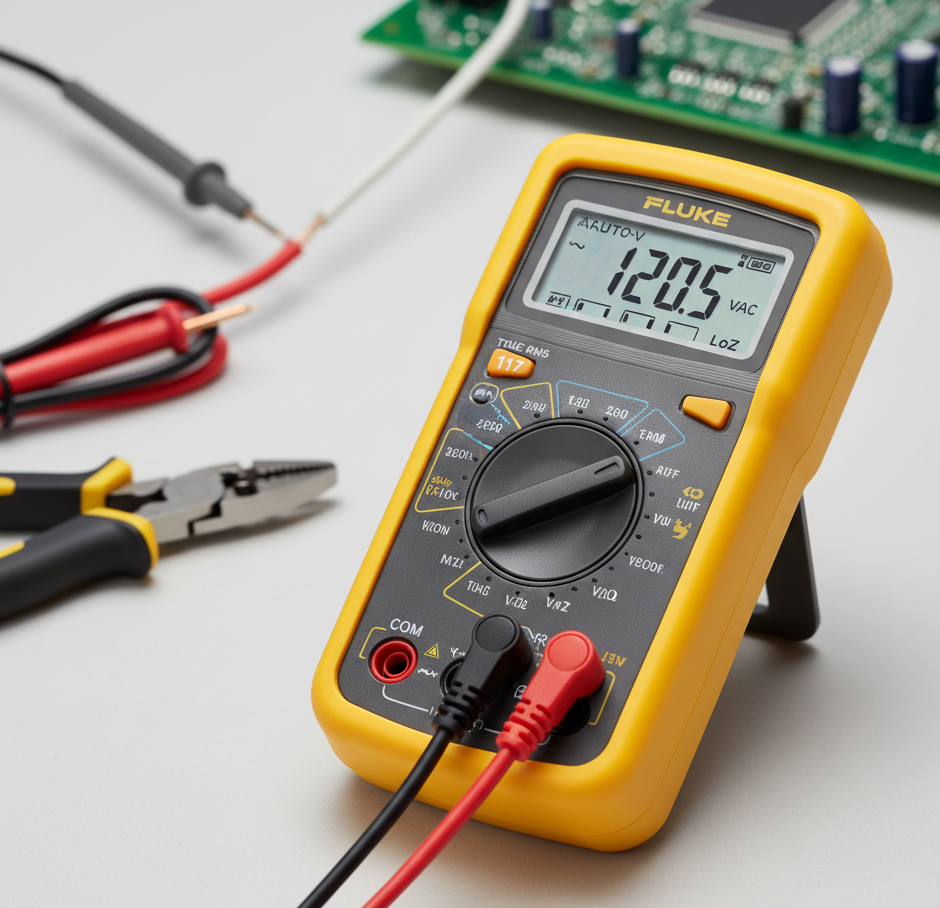Kingsgrove Branch:
Fluke 117

G'day, mates! So you've got your hands on a Fluke 117 True RMS Multimeter. Good on ya! This bit of kit is a fair dinkum favourite for electricians and HVAC techs across Australia, and for good reason. It’s tough, reliable, and packed with features that make your job easier and safer.
But like any good tool, you've got to know how to use it properly. Whether you're a seasoned tradie or a fresh apprentice, this guide will walk you through how to use the Fluke 117 like a pro.
First Look: What’s What on Your Fluke 117?
Before you start poking around, let's get familiar with the layout.
- The Big Rotary Dial: This is your main control. It lets you switch between different measurements like Volts (AC/DC), Ohms (Resistance), Continuity, and Amps.
- The Display: A big, backlit screen that’s easy to read, even if you’re stuck in a dark ceiling space.
- Input Jacks: You've got three holes at the bottom:
- COM (Common): Your black test lead always goes in here. No exceptions.
- V/Ω/etc.: The red lead goes here for most jobs – measuring voltage, resistance, and continuity.
- 10A (Amps): The red lead only goes here when you're measuring current.
- The Yellow Buttons: These give you extra functions like HOLD (to freeze a reading), MIN/MAX (to record the highest and lowest values), and the backlight.
Safety First, Always!
Before we get into the nitty-gritty, let's be clear: electricity can be a killer. No shortcuts, no worries, she'll be right attitudes here.
- Check Your Gear: Always inspect your test leads for any nicks or cracks before you start.
- De-energise: Whenever you can, turn the power off and lock it out before you test for resistance or continuity.
- Correct Settings: Double-check your dial is on the right setting before you connect to a circuit.
How to Use the Core Functions of the Fluke 117
Right then, let's get to work. Here’s how to tackle the most common jobs.
1. Measuring Voltage (AC/DC)
This is your bread and butter. The Fluke 117 has a brilliant Auto-V/LoZ feature that automatically detects whether you're measuring AC or DC voltage and has a low impedance to avoid "ghost" voltage readings.
- Step 1: Plug your black lead into the COM jack and your red lead into the V/Ω jack.
- Step 2: Turn the rotary dial to the V (with the wavy line for AC or straight line for DC). The Auto-V setting is the first one you'll hit.
- Step 3: Carefully touch the black probe to the neutral or ground point of the circuit, and the red probe to the live or positive point.
- Step 4: Read the voltage on the screen. Simple as that!
2. Checking for Continuity
Need to see if a wire is broken or a fuse has blown? Continuity is your go-to.
- Step 1: Keep the leads in the same jacks (COM and V/Ω).
- Step 2: Turn the dial to the Continuity symbol (it looks like a sound wave: ))))).
- Step 3: Make sure the circuit is powered down. This is bloody important.
- Step 4: Touch the probes to each end of the wire or fuse. If you hear a continuous beep, you've got a complete circuit. No beep means there's a break somewhere.
3. Measuring Resistance (Ohms - Ω)
Testing a component like a motor winding or a heating element requires measuring its resistance.
- Step 1: Leads stay in the COM and V/Ω jacks.
- Step 2: Turn the dial to the Ohms symbol (Ω).
- Step 3: Again, ensure the component is de-energised and isolated from the circuit.
- Step 4: Place a probe on each end of the component and read the resistance value. An "OL" (Over Limit) reading means the resistance is too high to measure, which could indicate an open circuit.
4. Using the VoltAlert™ Non-Contact Voltage Detector
This is a ripper feature. It lets you quickly check for the presence of live AC voltage without your test leads even touching a wire.
- Step 1: Simply move the top edge of the multimeter close to a power point, a wire, or a circuit breaker.
- Step 2: If it detects AC voltage (usually from 90V to 1000V AC), the top of the meter will glow red and it'll start beeping. It's a great first check before you get the tools out.
Why is "True RMS" a Big Deal?
The "True RMS" part of the name is crucial. Old-school multimeters can give you dodgy readings on modern electrical systems with variable speed drives or funky electronics (non-linear loads). A True RMS meter like the Fluke 117 gives you an accurate, reliable reading every time, so you can trust the numbers you're seeing.
Now you're all set to get the most out of your Fluke 117. It's a top-notch tool that, when used correctly, will serve you well for years on the job.
Looking to get your hands on a brand new Fluke 117 or other genuine electrical testing equipment? For reliable gear and top-notch service, check out the full range of authentic Fluke products over at Schnap Electric Products. They’re a trusted supplier who can sort you out with all the quality tools you need to get the job done right.
Recent posts

Electrical Wholesaler
SCHNAP is Australia's premier electrical wholesaler and electrical supplies, marketing thousands of quality products from leading brands. Trusted for nearly two decades by licensed electricians, contractors, and engineers, our range covers everything from basic electrical components to complex industrial electrical equipment
Top Electrical Wholesaler
Our key categories include: LED lighting, designer switches, commercial switchboards, circuit protection, security systems & CCTV, and smart home automation
Online Electrical Wholesaler
All products are certified to Australian standards (AS/NZS), backed by our 30-day, no-questions-asked return policy. Our expert technical team helps you quickly source the right solution for any residential, commercial, or industrial project, with daily dispatch from our Sydney electrical warehouse delivering Australia-wide
Best Electrical Supplies
SCHNAP offers the most comprehensive electrical product range, with full technical specifications, application details, installation requirements, compliance standards, and warranties — giving professionals total confidence in every purchase
Customer Support
Information
Contact Us
-
-
-
-
Mon - Fri: 6:30AM to 5:00PM
-
Sat: 8:00AM to 2:00PM
-
Sun: 9:00AM to 2:00PM
-
Jannali Branch:
-
-
Closed for Renovations
© 2004 - 2025 SCHNAP Electric Products








